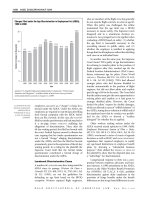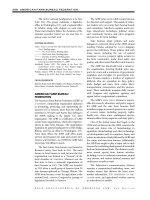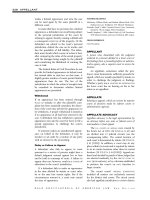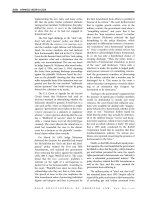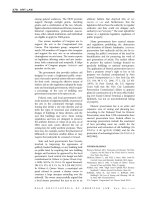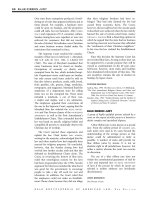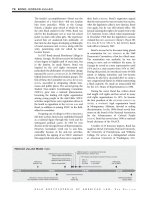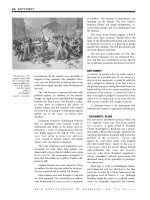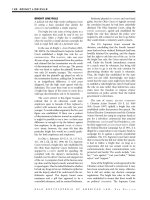Gale Encyclopedia Of American Law 3Rd Edition Volume 5 P35 pptx
Bạn đang xem bản rút gọn của tài liệu. Xem và tải ngay bản đầy đủ của tài liệu tại đây (431.4 KB, 10 trang )
era when it made significant changes in its
views on the constitutional limits on govern-
ment power.
Hughes was born April 11, 1862, in Glen
Falls, New York. Educated at Columbia Univer-
sity Law School, he spent his twenties and
thirties in private practice and teaching law at
Columbia and Cornell Universities. His exper-
tise was in
COMMERCIAL LAW and by the time he
was in his forties he had built a considerable
reputation in that area. The New York state
legislature chose him in 1905 to lead public
investigations of the gas and electrical utilities
in New York City and to probe the state’s
insurance industry. His work not only resulted
in groundbre aking regulatory plans, later highly
influential across the United States, but also
catapulted Hughes into a political career. He
immediately ran for governor of New York and
twice won election to that office as a politician
known for independence of mind and commit-
ment to administrative reform. In 1910 his
second term as governor had not yet expired
when he stepped down and accepted President
William Howard Taft’s appointment to the
Supreme Court.
This move characterized the lifelong ten-
sion between Hughes’s attractions to the legal
and political spheres. He left public office to
join the Court; later he would leave the Court
to run for office again, then return to the Court
as chief justice. In his nearly seven years on
the Court as an associate justice, he displayed
a flexibility of thought that led him to side
at times with liberals and at times with the
conservative majority. His most significant
opinions turned on the issue o f federal power.
In particular, these opinions weighed the extent
to which the
COMMERCE CLAUSE of the Constitu-
tion gave the federal government authority to
regulate the national economy. The opinions
were delivered in the Minnesota and Shreveport
Rate cases, in which the Court’s decisions laid
the groundwork for the expansion of federal
regulation in the ye ars to come (Simpson v.
Shepard, 230 U.S. 352, 33 S. Ct. 729, 57 L. Ed.
1511 [1913]; Houston, East & West Texas Railway
Co.v.UnitedStates,234 U.S. 342, 34 S. Ct. 833, 58
L. Ed. 1341 [1914]).
Charles Evans Hughes 1862–1948
❖
1862 Born,
Glen Falls, N.Y.
1884 Graduated
from Columbia
Law School, joined
Wall St. firm of
Hornblower, Carter
and Chamberlin
1921–25 Served
as secretary of
state under
Coolidge
1914–18
World War I
1948 Died,
Osterville,
Mass.
1861–65
U.S. Civil War
1930–41 Served as chief
justice of the U.S.
Supreme Court
1939–45
World War II
▼▼
▼▼
19001900
19251925
1950 1950
18501850
18751875
❖
◆
1905–06 Served as
counsel to the New York
Investigating Commission
1937 Wrote majority opinion
upholding National Labor
Relations Act (NLRB v. Jones
& Laughlin Steel Corp.)
◆
◆
1935 Supreme Court unanimously
held the National Industrial Recovery
Act unconstitutional (Schecter Poultry
Corp. v. United States)
1907–10 Served as
governor of New York
1910–16 Served as associate
justice of the U.S. Supreme Court
◆
1916 Ran as Republican party candidate for president,
lost by 23 electoral votes to Woodrow Wilson
1926–30 Served as
judge on Permanent
Court of Arbitration
Charles Evans
Hughes.
PHOTOGRAPH BY
HARRIS & EWING.
COLLECTION OF THE
SUPREME COURT OF THE
UNITED STATES
GALE ENCYCLOPEDIA OF AMERICAN LAW, 3RD E DITION
328 HUGHES, CHARLES EVANS
The middle years of Hughes’s career saw
tumultuous change. In 1916 he stepped down
from the Court to return to politics. Although
he had not actively sought the Republican
Party’s nomination for president, the party
drafted him, and he reluctantly agreed to run
against
WOODROW WILSON. Despite a hard-fought
campaign, Hughes lost the close election and
returned to private practice. His respite from
public service was brief. In 1921 President
WARREN G. HARDING appointed Hughes secretary
of state, a difficult position because of the
challenges facing the United States in the after-
math of
WORLD WAR I: the war debt, reparations,
the newly established Soviet Union, and espe-
cially relations with East Asia. Naval disarma-
ment ranked high among Hughes’s concerns. In
1921 and 1922 he organized the Washington
Conference, which for nearly a decade curbed
naval growth and brought stability to the
western Pacific.
The final chapter in Hughes’s career
returned him to the Supreme Court. Hughes
served as secretary of state to Har ding’s
successor,
CALVIN COOLIDGE, then resigned in
1925 to work in private practice. Between that
and his next stint on the Court, he published a
book-length work entitled The
SUPREME COURT OF
THE UNITED STATES
: Its Foundation, Methods, and
Achievements: An Interpretation (1928, reprinted
2000). In 1930 President
HERBERT HOOVER
nominated him for chief justice. Bitter oppo-
nents voiced criticism of Hughes’s political
career and his resignation but failed to block
his appointment in a confirmation vote of 52–
26. At age 68, Hughes became the oldest man
ever to be chose n chief justice.
The Hughes Court sat during a controver-
sial period in U.S.
LEGAL HISTORY. The Depression
years had brought misery and a radical federal
response. President Franklin D. Roosevelt’s
economic recovery plans, known collectively
as the New Deal, met opposition in Congress
and from the justices of the Court. Several
pieces of New Deal legislation faced constitu-
tional tests and failed. After unanimously
holding unconstitutional the National Industrial
Recovery Act (48 Stat. 195 [1933])inSchechter
Poultry Corp. v. United States, 295 U.S. 495, 55
S. Ct. 837, 79 L. Ed. 1570 (1935), the Court
provoked a battle with the frustrated president.
Roosevelt proposed an increase to the number
of seats on the Court, hoping to then pack the
Court with justices favorable to his views.
Hughes wrote to the
SENATE JUDICIARY COMMITTEE
in a move to help thwart Roosevelt’s plan.
By taking a largely dim view of both federal
and state regulatory power, the Hughes Court
differed little from its conservative predecessors.
In 1937 this changed dramatically. In upholding
the National Labor Relations Act, 29 U.S.C.A. §
151 et seq., Hughes wrote a landmark opinion
that greatly strengthened the labor movement
(
NLRB V. JONES & LAUGHLIN STEEL CORP., 301 U.S. 1,
57 S. Ct. 615, 81 L. Ed. 893 [1937]). Also that
year the Court upheld a state
MINIMUM WAGE law,
in West Coast Hotel v. Parrish, 300 U.S. 379, 57
S. Ct. 578, 81 L. Ed. 703. The Parrish decision
was a striking departure from rulings of previous
decades. Only 15 years earlier, for example, the
Court had refused to force employers of adult
women to pay a minimum wage, viewing such a
requirement as an unconstitutional infringe-
ment of the liberty of contract. The 1937
decisions together have been called a constitu-
tional revolution because they marked a great
change in jurisprudence that liberalized the
Court’s view of government power.
When Hughes retired at last in 1941, at age
80, he had made a powerful impression on the
law and on the Court. During his tenure as chief
justice, he had shown the same flexibility of
mind that marked his period as an associate
justice: Siding alternately with liberal and
conservative colleagues, he often cast the swing
vote. He had clearly run the Court with a strong
hand, not only in leading the discussion but
frequently in persuading justices to vote with
him. Justice
FELIX FRANKFURTER, who served
under Hughes, likened him to the conductor
of an orchestra: “He took his seat at the center
of the Court with a mastery, I suspect,
unparalleled in the history of the Court.”
Hughes died August 27, 1948, in Osterville,
Massachusetts. Succeeding generations have
compared his bold leadership to that of Chief
Justice
EARL WARREN, who headed the Court two
decades later.
FURTHER READINGS
Hall, Timothy L. 2001. Supreme Court Justices: A Biographi-
cal Dictionary. New York: Facts on File.
Perkins, Dexter. 1978. Charles Evans Hughes and American
Democratic Statesmanship. Westport, CT: Greenwood.
Schwartz, Bernard. 1995. “Supreme Court Superstars: The
Ten Greatest Justices.” Tulsa Law Journal 31 (fall).
CROSS REFERENCES
Labor Law; Labor Union; Supreme Court of the United States.
WHEN WE LOSE THE
RIGHT TO BE
DIFFERENT
, WE LOSE
THE PRIVILEGE TO
BE FREE
.
—CHARLES EVANS
HUGHES
GALE ENCYCLOPEDIA OF AMERICAN LAW, 3RD E DITION
HUGHES, CHARLES EVANS 329
HUMAN RIGHTS
Basic rights that fundamentally and inherently
belong to each individual.
HUMAN RIGHTS are freedoms established by
custom or international agreement that impose
standards of conduct on all nations. Human
rights are distinct from civil liberties, which are
freedoms established by the law of a particular
state and applied by that state in its own
jurisdiction.
Specific human rights include the right to
personal liberty and
DUE PROCESS OF LAW;to
freedom of thought, expression,
RELIGION, orga-
nization, and movement; to freedom from
discrimination on the basis of race, religion,
age, language, and sex; to basic education; to
employment; and to property. Human rights
laws have been defined by international conven-
tions, by treaties, and by organizations, particu-
larly the
UNITED NATIONS. These laws prohibit
practices such as torture,
SLAVERY,summary
execution without trial, and arbitrary detention
or exile.
History
Modern human rights law developed out of
customs and theories that established the rights
of the individual in relation to the state. These
rights were expressed in legal terms in docu-
ments such as the English
BILL OF RIGHTS of 1688,
the U.S.
DECLARATION OF INDEPENDENCE of 1776,
the U.S. Bill of Rights added to the U.S.
Constitution in 1789, and the French Declara-
tion of the Rights of Man and the Citizen added
to the French Cons titution in 1791.
Human rights law also grew out of earlier
systems of
INTERNATIONAL LAW. These systems,
developed largely during the eighteenth and
nineteenth centuries, were predicated on the
doctrine of national sovereignty, according to
which each nation retains sole power over its
internal affairs without interference from other
nations. As a result, early international law
involved only relations between nation-states
and was not concerned with the ways in which
states treated their own citizens.
During the late nineteenth and early twenti-
eth centuries, the notion of national sovereignty
came under increasing challenge, and reformers
began to press for international humanitarian
standards. In special conferences such as the
Hague Conference of 1899 and 1907, nations
created laws governing the conduct of wars and
handling of prisoners.
Not until after
WORLD WAR II (1939–45) did
the international community create internation-
al treaties establishing human rights standards.
The United Nations, created in 1945, took the
lead in this effort. In its charter, or founding
document, the United Nations developed
objectives for worldwide human rights stan-
dards. It called for equal rights and self-
determination for all peoples, as well as
“universal respect for, and observance of,
human rights and fundamental freedoms for
all without distinction as to race, sex, language,
or religion” (art. 55). The Universal Declaration
of Human Rights, adopted by the U.N. General
Assembly in 1948, also became an important
human rights document.
To develop the U.N. Charter into an inter-
national code of human rights law, the
international community created a number of
multilateral human rights treaties. The two
most significant of these are the International
Covenant on Civil and Political Rights and the
International Covenant on Economic, Social,
and Cultural Rights, both put into effect in
1976. These treaties forbid discrimination on
the basis of race, color, sex, language, religion,
political or other opinion, national or social
origin, property, birth, or other status. The two
covenants, along with the U.N. Charter, the
Universal Declaration of Human Rights, and an
accord called the Optional Protocol to the
Covenant on Civil and Political Rights (1976),
constitute a body of law that has been called the
International Bill of Human Rights.
The Covenant on Civil and Political Rights
includes protections for the right to life, except
after conviction for serious crime (art. 6);
freedom from torture and other cruel and
inhumane punishment (art. 7); freedom from
slavery and prohibition from slave trade (art. 8);
freedom from arbitrary arrest or detention (art.
9); humane treatment of prisoners (art. 10);
freedom of movement and choice of residence
(art. 12); legal standards, including equality
before the law, fair hearings before an impartial
tribunal,
PRESUMPTION OF INNOCENCE, a prompt
and fair trial, the
RIGHT TO COUNSEL, and the right
to review by a higher court; freedom of thought,
conscience, and religion (art. 18); and freedom
of association, including association in trade
unions (art. 22).
The Covenant on Economic, Social, and
Cultural Rights protects additional rights, many
of which have yet to be realized in poorer
GALE ENCYCLOPEDIA OF AMERICAN LAW, 3RD E DITION
330 HUMAN RIGHTS
countries. These include the right to work (art.
6); to just wages and safe working conditions
(art. 7); to
SOCIAL SECURITY and social insurance
(art. 9); to a decent standard of living and
freedom from hunger (art. 11); to universal
basic education (art. 13); and to an enjoyment
of the cultural life and scientific progress of the
country.
The international community has also
adopted many other human rights treaties.
These include the Convention on the Preven-
tion and Punishment of the Crime of
GENOCIDE
(1948); the Convention on the Political Rights
of Women (1953); the Convention to Suppress
the Slave Trade and Slavery (revised 1953); the
Convention against Torture and Other Cruel,
Inhuman, or Degrading Treatment (1987); the
Convention on the Rights of the Child (1990);
and the Convention on Protection of the Rights
of Migrant Workers (2003).
In addition to worldwide human rights
agreements, countries have also established
regional conventions. These include the Euro-
pean Convention for the Protection of Human
Rights and Fundamental Freedoms, the Ameri-
can Convention on Human Rights, and the
African Charter on Human and People s’ Rights.
The United States and Human Rights
Although the United States was an active
participant in the forma tion and implementa-
tion of international human rights organiza-
tions and treaties following World War II, and
although it ratified selected treaties such as the
Convention to Suppress the Slave Trade and
Slavery in 1967 and the Convention on the
Political Rights of Women in 1976, it did not
ratify any of the major rights treaties until 1988,
when it approved the Convention on the
Prevention and Punishment of the Crime of
Genocide. Four years later it ratified the
International Covenant on Civil and Political
Rights.
The U.S. Senate, which has authority to
ratify all treaties, has been slow to review and
approve human rights provisions, for a number
of reasons. Senators have expressed concern
about the effect of international treaties on U.S.
domestic law. Article VI of the U.S. Constitu-
tion provides, “This Constitution, and the Laws
of the United States which shall be made in
Pursuance thereof; and all Treaties made, or
which shall be made, under the Authority of the
United States, shall be t he supreme Law of the
Land.” Treaties therefore stand as federal
law, though they are not considered to be law
if they conflict with the Constitution (Reid v.
Covert, 354 U.S. 1, 77 S. Ct. 1222, 1 L. Ed. 2d
1148 [1957]).
Conservative senators blocked early ratifi-
cation of human rights treat ies largely out of
concern that the treaties would invalidate racial
SEGREGATION laws that existed in the United
States until the 1960s. Many human rights
advocates claimed that these laws violated
existing international treaties. Some senators
argued that human rights should fall under
domestic auth ority only and should not be
subject to international negotiations. Others
contended that ratification of human rights
treaties would federalize areas of law be tter left
to the states.
Since the late 1960s such objections in the
Senate have been overcome by attaching to
treaties modifying terms called reservations,
understandings, and declarations (RUDs).
RUDs modify the treaties so that their effect
on U.S. law will be acceptable to the two-thirds
majority required for treaty ratification in the
Senate. A reservation, for example, may state
that the United States will not accept any
element of a treaty found to be in conflict with
the U.S. Constitution or existing laws, or that
ratification will not federalize areas of law
currently controlled by the states.
The U.S. Congress has also enacted its own
human rights legislation. Under the leadership
of Representative Donald M. Fraser (D-Minn.)
during the 1970s, the House Committee on
Foreign Affairs added language to the Foreign
Assistance Act of 1973 (22 U.S.C.A. § 2151 et
seq.) that required the president to cancel
military and economic assistance to any gov-
ernment that “engages in a consistent pattern of
gross violations of internationally recognized
human rights,” including torture and arbitrary
detention without charges (§§ 2151n, 2304).
This new legislation authorized the
STATE
DEPARTMENT
to collect and analyze data on
human rights violations. Congress has also
passed laws that require cutting off or limiting
aid to countries with significant human rights
violations.
In 1977 Congress gave human rights greater
priority within the executive branch by creating
a new State Department office, the Bureau on
GALE ENCYCLOPEDIA OF AMERICAN LAW, 3RD E DITION
HUMAN RIGHTS 331
Human Rights and Humanitarian Affairs,
headed by an assistant
SECRETARY OF STATE
(Pub. L. No. 95-105, 91 Stat. 846). In 1994,
the administratio n of President
BILL CLINTON
renamed the office the Bureau for Democracy,
Human Rights, and Labor. The bureau is
charged with administering programs and
policies to promote democratic institutions
Torture
N
o government wants to admit that
it has committed torture. Apart
from international agreements that ban
torture, such as the United Nation’s
Convention Against Torture, the cruelty
inherent in the act of torture can de-
legitimize the officials who authorize it.
Therefore, officials will do what they can
to distinguish their interrogations from
acts of torture. The Convention Against
Torture defines it as “any act by which
severe pain or suffering, whether physical
or mental, is intentionally inflicted on a
person for such purposes as [obtaining
information or a confession, intimida-
tion or coercion, or discrimination].”
Defining what constitutes “severe pain or
suffering” is what drove the torture
debate over the U.S. interrogations of
suspected terrorists during the adminis-
tration of President
GEORGE W. BUSH.
A 50-page, 2002 memo from the
Justice Department’s Office of Legal
Counsel (OLC) about permissible inter-
rogation tactics brought the Bush ad-
ministration strong criticism after its
release in 2004. The memo, written after
the CIA requested legal advice following
the
SEPTEMBER 11, 2001, TERRORIST ATTACKS,
addressed legally defensible methods of
interrogation for al Qaeda terrorist
suspects. Surprisingly, the memo said
that the torture of suspected al Qaeda
terrorist “may be justified” and that
international laws against torture “may
be unconstitutional if applied to interro-
gation” when used against suspected
terrorists. The memo concluded that
“certain acts may be cruel, inhuman, or
degrading, but still not produce pain and
suffering of the requisite intensity” to be
classified as torture.
The memo examined various aspects
of the Convention Against Torture, as
found in title 18, Sections 2340 P 2340A
of the United States Code. The memo
came in response to questions that arose
during the interrogation in early 2002 of
al Qaeda operations chief Abu Zubaida.
The CIA was frustrated over its lack of
progress with the interrogation and
wanted to know how far it could legally
go without violating the law. Neither the
military nor the
STATE DEPARTMENT was
consulted for assistance in preparation or
review of the memo.
The memo stated that physical
torture “must be equivalent in intensity
to the pain accompanying serious physi-
cal injury, such as organ failure, im-
pairment of bodily function, or even
death.” In other words, torture means
“pain that is difficult to endure.” Accord-
ing to the memo, in order for psycholog-
ical methods of interrogation to rise to
the level of torture, they must result in
“significant psychological harm of a
significant duration,” meaning the harm
must last “months or even years.”
According to the memo, “a
DEFENDANT
must specifically intend to cause pro-
longed mental harm” for the act(s) to be
considered torture; “specific intent only
to commit the predicate acts that give
rise to prolonged mental harm” would
not constitute torture. Moreover, if an
interrogator “has a
GOOD FAITH belief that
his actions will not result in prolonged
mental harm,” he will have valid defense
against conviction for unlawful torture.
Certain mind-altering drugs, which do
not profoundly disrupt the senses or
personality, would also be permitted in
interrogation.
Another section of the memo exam-
ined whether the Convention Against
Torture “may be unconstitutional if
applied to interrogations of enemy
combatants pursuant to the President’s
Commander-in-Chief powers.” The
memo concluded that interrogators
who engaged in torture could be pro-
tected from criminal prosecution.
After the memo was made public,
administration officials maintained that
the president consistently insisted that all
methods of interrogation conform to
U.S. and international laws and treaties.
HUMAN RIGHTS observers blamed the
document for leading to abuses against
prisoners at the Abu Ghraib prison in
Iraq, in Afghanistan, and at Guantanamo
Bay, Cuba, where suspected terrorists
were detained.
A December 2004 memo from the
OLC superseded, in its entirety, the
August 2002 memo. According to
the new memo, “torture is abhorrent both
to American laws and values and to
international norms.” The new 17-page
memo backed away from any claims in
the August 2002 memo that the president
might be legally justified in departing
from U.S. law on torture in times of war
and that there might exist some legally
defensible ways around criminal charges
for those who employ torture. According
to the new memo, the August 2002 memo
was wrong when it stated that only
“excruciating and agonizing pain” consti-
tuted torture. Moreover, the earlier memo
was wrong when it said that criminal
prosecution would be limited to cases
where severe pain was imposed for its own
sake,ratherthantoobtaininformation.
GALE ENCYCLOPEDIA OF AMERICAN LAW, 3RD E DITION
332 HUMAN RIGHTS
and respect for human rights and workers’
rights around the world. It also presents to
Congress an annual report on the status of
human rights all over the globe.
Nongovernment Organizations
AMNESTY INTERNATIONAL,theCENTER FOR CONSTITU-
TIONAL RIGHTS
, HUMAN RIGHTS WATCH, the Interna-
tional Commiss ion of Jurists, and other
The new memo stated that U.S.
interrogators did not have a defense to
allegations of torture by claiming that
they were guided by national security
reasons. Moreover, the memo prohibited
telling a detainee that he could avoid
torture only by cooperating. The memo
also rejected the prior claim that torture
is limited to physical suffering that
involves severe physical pain or even
death, but says it must be more than
“mild and transitory” suffering. Mental
suffering need not last months or years,
as the original document claimed, and
need not be permanent, but “must
continue for a prolonged period of time.”
The use of torture or what the Bush
administration labeled “enhanced interro-
gation,” led to the dropping of charges
against one detainee. In May 2008 the top
official responsible for overseeing military
trials of suspected terrorists held at the U.
S. detention prison at Guantanamo Bay,
Cuba, dismissed the pending case against
Mohammed al-Qahtani because he had
been subjected to torture. According to
Susan J. Crawford, convening authority of
military commissions, interrogation tech-
niques used against Qahtani were autho-
rized at the time (2002), but “his
treatment met the l egal definition of
torture,” causing her to order war-crime
charges against him dropped.
A military report indicated that
Qahtani was threatened with a military
working dog, forced to wear a woman’s
bra, had a thong placed on his head
during interrogation, and was told that
his mother and sister were “whores. ” At
one point, a leash had been tied to his
chains as he was led around a room,
forced to perform dog tricks. Addition-
ally, interrogation techniques included
sustained isolation, sleep deprivation,
and prolonged exposure to cold tem-
peratures. However, it was the fact that
Qahtani was hospitalized twice following
interrogations that led Crawford to her
conclusion. His diagnosis was bradycar-
dia, a condition in which the heart rates
slows to dangerously low levels, leading
to heart failure and death. Bradycardia
can be directly linked to cold body
temperature and fatigue. In October
2006 Qahtani recanted a confession he
said he had made after enduring such
interrogation methods.
Revelations that some terrorist sus-
pects were water boarded many times
also drew criticism. Water boarding is a
technique involving the simulation of
drowning. It involves binding a person to
an inclined board, covering his or
her head with cloth or cellophane, and
pouring water repeatedly over the face
and head. In some cases water actually
enters the nose and mouth, but mostly,
the sensation of water hitting the face
(cloth or cellophane) causes a psy-
chological reaction during which the
brain processes information of drown-
ing, which causes a gag reflex similar to
choking.
John Yoo, a lawyer with OLC,
prepared a memo in 2003 for military
interrogators that was similar to its 2002
memo for civilian interrogators. The
memo approved of the use of water
boarding, as well as head-slapping, sleep
deprivation, and exposure to extreme
temperatures. However, the OLC offi-
cially rejected the “flawed reasoning” in
the memo. Nevertheless, the Bush ad-
ministration contended that the CIA’s
water boarding against three top al Qaida
detainees, Khalid Sheikh Mohammed,
Abu Zubaydah, and Abd al-Rahim al-
Nashiri was legal. The practice was ended
in 2006.
Congress passed the Detainee Treat-
ment Act in 2005, requiring the
DEPART-
MENT OF DEFENSE
to restrict interrogation
methods to those set out in the Army
Field Manual, which banned coercive
interrogations. In 2007 President Bush
issued an executive order narrowing the
list of approved techniques for the CIA.
Although that list of authorized techni-
ques remained classified, intelligence
officials stated that water boarding was
not on the list of approved techniques
but that President Bush could authorize
it during an emergency.
In December 2007 the CIA admitted
that it had destroyed video tapes of the
interrogations of some key Iraqi detai-
nees. In 2008 the House Judiciary
Committee conducted hearings into the
meaning and parameters of torture,
particularly as applied to detainees held
outside the United States. When John
Yoo was called to testify, he declared
EXECUTIVE PRIVILEGE. David Addington,
former chief of staff to Vice President
Dick Cheney, could not “recollect”
matters of substance or interest. Former
CIA director George Tenet testified that
the value of water boarding and other
“enhanced” methods of interrogation
“far exceeded” any other method(s).
Former attorney general
JOHN ASHCROFT
also testified that water boarding was not
torture and that it had been approved by
JUSTICE DEPARTMENT officials before being
employed. All administration officials
denied that any illegal “torture” was
involved in military interrogations.
When the administration of Barack
Obama took office in 2009, it released
internal papers showing the extent of
interrogative techniques used during the
Bush years. President Obama called this a
“dark period” in U.S. history and vowed
to end it and “move on.” To accomplish
this objective, Attorney General Eric
Holder announced that interrogators
would not be prosecuted for their
actions. It also became clear the admin-
istration had no interest in further
investigations.
FURTHER READINGS
Levinson, Sanford, ed. 2006. Torture: A
Collection. New York: Oxford Univ. Press.
GALE ENCYCLOPEDIA OF AMERICAN LAW, 3RD E DITION
HUMAN RIGHTS 333
international human rights organizations close-
ly monitor states’ complia nce with human
rights standards. These groups also publicize
rights violations and coordinate world public
opinion against offending states. In many cases
they induce governments to modify their
policies to meet rights standards.
Domestic human rights organizations such
as the Vicaria de Solidaridad, in Chile, and the
Free Legal Assistance Group of the Philippines
also play a significant role as human rights
watchdogs, often at great personal risk to their
members.
FURTHER READINGS
Amnesty International Website. Available online at http://
www.amnesty.org (accessed July 31, 2009).
Curry, Lynne. 2004. The Human Body on Trial: A Sourcebook
with Cases, Laws, and Documents (on Trial). Indiana-
polis: Hackett.
Golove, David. 2002. “Human Rights Treaties and the U.S.
Constitution.” DePaul Law Review 52 (winter).
Kennedy, David. 2002. “The International Human Rights
Movement: Part of the Problem?” Harvard Human
Rights Journal 15 (spring). Available online at http://
www.law.harvard.edu/students/orgs/hrj/iss15/kennedy.
shtml; website home page:
(accessed July 31, 2009).
State Department. “Bureau of Democracy, Human Rights,
and Labor.” Available online at />dr; website home page: (accessed
July 31, 2009).
CROSS REFERENCES
Civil Rights; Genocide; Nuremberg Trials; Tokyo Trial.
HUMAN RIGHTS WATCH
HUMAN RIGHTS WATCH (HRW) investigates HUMAN
RIGHTS
abuses throughout the world, publishing
its findings in books and reports every year.
These activities often generate significant cover-
age in local and international media. This
publicity in turn prompts governments to
change their policies and practices. In cases of
extreme human rights abuses, HRW advocates
for the withdr awal of military and economic
support from governments that violate the
rights of their people.
In international conflicts and other crises,
HRW provides current information about
conflicts—focusing on the human rights situa-
tion on the ground—while the conflicts or crises
are underway. The purpose of HRW is to
increase the price of human rights abuse, thereby
helping to decrease the incidents of such abuses.
HRW is the largest human rights organiza-
tion based in the United States. HRW employs
lawyers, journalists, academics, and country
experts of many nationalities and diverse back-
grounds, and often leverages the force of allied
human rights organizations by joining forces
with them to achieve shared human rights goals.
As of February 2002, Human Rights Watch
employed 189 permanent staff plus short-term
fellows and consultants.
Human Rights Watch is an independent,
nongovernmental organization. It gains most of
its support from contributions from private
individuals and foundations worldwide. It accepts
no government funds, directly or indirectly, from
the United States or any other government. HRW
is not an agency of the U.S. government, nor was
it founded by the U.S. government. Although
HRW frequently calls on the United States to
support human rights in U.S. foreign policy, the
organization also reports on human rights abuses
inside the United States. HRW has made negative
reports against the United States in areas such
as prison conditions, police abuse, the detention
of immigrants, and the imposition of the death
penalty.
HRW maintains its headquarters in New
York. It also maintains offices in Brussels,
Bujumbura, Freetown (Sierra Leone ), Kigali,
Geneva, London, Los Angeles, Moscow, San
Francisco, Santiago de Chile, Tashkent, Tbilisi,
and Washington.
Most HRW research is carried out by
sending fact-finding teams into countries where
there have been allegations of serio us human
rights abuses. HRW examines the human rights
practices of governments of all political stripes,
of all geopolitical alignments, and of all ethnic
and religious persuasions. HRW documents and
denounces murders, disappearances, torture,
arbitrary imprisonment, discrimination, and
other abuses of internationally recognized
human rights.
Not only does HRW encompass the entire
globe for its activities, but HRW is interested in
enormously complex and diverse issues. For
example, HRW follows developments world-
wide in women’s rights, children’s rights, and
the flow of arms to abusive forces. Other HRW
projects include
ACADEMIC FREEDOM, the human
rights responsibilities of corporations, inter-
national justice, prisons, drugs, and refugees.
The unique and independent nature of this
GALE ENCYCLOPEDIA OF AMERICAN LAW, 3RD E DITION
334 HUMAN RIGHTS WATCH
international organization enables it to target
any and all partie s to conflict.
HRW pursues active investigations of hu-
man rights abuses in more than 70 countries. Its
methods for obtaining human rights informa-
tion has made it a credible source of informa-
tion for individuals and governments concerned
with human rights. To conduct research,
Human Rights Watch sends members of its
staff to interview people who have firsthand
experience with alleged abuse. Researchers work
with local activists and other specialists. Their
findings are written up in reports.
HRW rep orts categorize and describe hu-
man rights violations, detail probable causes for
the abuses, and make recommendations for
ways to end the abuses. HRW has published
more than a thousand reports dealing with
human rights issues in more than one hundred
countries worldwide. HRW has used its inves-
tigations to examine human rights violations
associated in the following cases: Taliban
massacres in Afghanistan; trafficking of Thai
women in Asia;
RAPE in U.S. prisons; refugees in
Sierra Leone; and conflicts in Indonesia,
Macedonia, Colombia, Russia, and the Congo.
Since its formation, HRW has focused
mainly on upholding civil and political rights.
HRW began in 1978 with the founding of its
European division, Helsinki Watch (now Human
Rights Watch/Helsinki). This was in response to
a call for support from groups in Moscow,
Warsaw, and Prague, which had been established
to monitor compliance in Soviet Bloc countries
with the human rights provisions of the
landmark Helsinki accords. A few years
later, the Reagan administration contended that
human rights abuses by certain right-wing
governments were more tolerable than those of
left-wing governments. Thus, to counter charges
of maintaining a double standard between the
East and West, HRW formed Americas Watch
(now Human Rights Watch/Americas).
By 1987 HRW had developed a powerful set
of techniques for pursuing its agenda: painstak-
ing documentation of abuses and aggressive
advocacy in the press and with governments,
and it employed these techniqu es all over the
world. Over time, the organization grew to
cover other regions of the world. Eventually, all
the “Watch” committees were united in 1988 to
form Human Rights Watch.
Between 1993 and 2003 HRW increasingly
addressed economic, social, and cultural rights as
well. It is particularly attuned to situations in
which its methods of investigation and reporting
are most effective. These include cases in which
arbitrary or discriminatory governmental con-
duct lies behind an economic, social and cultural
rights violation. In addition to governments, its
work also addresses significant economic players
and such international financial institutions as
the
WORLD BANK and multinational corporations
such as General Electric.
In the early 2000s, HRW comprises seven
major divisi ons: Africa, the Americas, Arms,
Asia, Children, Women, the Middle East and
North Africa, and Europe and Central Asia.
FURTHER READINGS
Human Rights Watch. Available online at .
org/ (accessed July 31, 2009).
Human Rights Watch World Report. 2001: Events of 2000
(November 1999–October 2000). New York: Human
Rights Watch. Available online at />legacy/wr2k1/; website home page:
(accessed July 31, 2009).
Iriye, Akira. 2004. Global Community: The Role of Interna-
tional Organizations in the Making of the Contemporary
World. Berkeley: Univ. of California Press.
Pease, Kelly-Kate S. 2009. International Organizations:
Perspectives on Governance in the Twenty-First Century.
Upper Saddle River, NJ: Prentice Hall.
Welch, Claude E., Jr., ed. 2000. NGOs and Human Rights:
Promise and Performance. Philadelphia: Univ. of
Pennsylvania.
CROSS REFERENCE
Human Rights.
v
HUME, DAVID
David Hume was an eighteenth-century Scot-
tish philosopher, historian, and social theorist
who influenced the development of skepticism
and empiricism, two schools of philosophical
thought. Hume’s economic and political ideas
influenced Adam Smith, the Scottish economist
and theorist of modern capitalism, and
JAMES
MADISON
, the American statesman who helped
shape the republican form of government
through his work on the U.S. Constitution.
Hume was born August 25, 1711, in
Chirnside, near Edinburgh, Scotland. He en-
tered Edinburgh University when he was twelve.
He left the university after several years of study
and attempted to study law. He did not like the
subject, and instead read widely in philosophy.
In 1729 he suffered a nervous breakdown. After
THE HEART OF MAN
IS MADE TO
RECONCILE
CONTRADICTIONS.
—DAVID HUME
GALE ENCYCLOPEDIA OF AMERICAN LAW, 3RD E DITION
HUME, DAVID 335
a prolonged recovery, he moved to France in
1734, where he wrote his first work, A Treatise
on Human Nature. The book was not published
until 1739 and was largely ignored. His next
work, Essays, Moral and Political (1741),
attracted favorable notice. Throughout the
1740s Hume’s religious skepticism doomed his
chances for a professorship at Edinburgh
University. He spent the decade as a tutor and
then as secretary to a Scottish general. During
this period he wrote several more works of
philosophy, including An Enquiry Concerning
the Principles of Morals (1751).
In 1752 he was made librarian of the Faculty
of Advocates Library at Edinburgh. From 1754
to 1762, he published his monumental History
of England, which for many years was consid-
ered the bas ic text of English history. This work
brought him international fame. He later served
as secretary to the British counsel in Paris. He
died August 25, 1776, in Edinbu rgh.
As a philosopher, Hume espoused a skeptical
viewpoint, distrusting speculation. He believed
that all knowledge comes from experience and
that the mind contains nothing but a collection of
perceptions, that all events are viewed and
interpreted through the sensations of the mind.
He attacked the principle of causality, which
states that nothing can happen or exist without a
cause. Hume was willing to admit that one event,
or set of sense impressions, always precedes
another, but he argued that this did not prove
that the first event causes the second. A person
can conclude that causality exists, but that
conclusion is based on belief, not proof. There-
fore, a person cannot expect the future to be
similar to the past, because there is no rational
basis for that expectation.
Like his philosophical beliefs, Hume’s essays
on politics and economics were influential in
his time. Historians have concluded that James
Madison read Hume’s Essays, Moral and Politi-
cal and applied some of the ideas from this work
while helping write the Constitution and The
Federalist Papers. Hume was concerned about
the formation of factions based on
RELIGION,
politics, and other common interests. He
concluded that a democratic society needs to
prevent factions, which ultimately undermine
the government and lead to violence. Madison
agreed that factions can divide government but
came to the opposite conclu sion: the more
factions the better. In Madison’s view more
factions made it less likely that any one party or
coalition of parties would be able to gain
control of government and invade the rights
of other citizens. The system of checks and
balances contained in the Constitution was part
of Madison’s plan for placing some limits on
factions.
FURTHER READINGS
Allan, James. 1999. “To Exclude or Not to Exclude
Improperly Obtained Evidence: Is a Humean Approach
More Helpful?” Univ. of Tasmania Law Review 18
(October).
Arkin, Marc M. 1995. “‘The Intractable Principle’: David
Hume, James Madison, Religion, and the Tenth
Federalist.” American Journal of Legal History 39.
Mossner, Ernest Campbell. 2001. The Life of David Hume.
New York: Oxford Univ. Press.
Schmidt, Claudia M. 2004. David Hume: Reason in History.
State College, PA: Pennsylvania State Univ. Press.
Vermeule, Adrian. 2003. “Hume’s Second-Best Constitu-
tionalism.” Univ. of Chicago Law Review 70, no. 4
(winter).
CROSS REFERENCES
Hobbes, Thomas; Jurisprudence; Locke, John.
David Hume 1711–1776
❖
❖
1711 Born,
Chirnside,
Scotland
1739 A Treatise
on Human Nature
published
1741 Essays,
Moral and
Political published
1767–68 Served as
undersecretary of state
1776 Died,
Edinburgh,
Scotland
▼▼
▼▼
17001700
17501750
17751775
18001800
17251725
1775–83
American Revolution
1789
French
Revolution
◆◆◆
1751 An Enquiry Concerning the
Principles of Morals published
◆
◆
1752–63 Served as librarian on the Faculty
of Advocates Library at Edinburgh
1754–62 Multi-volume set, History of England, published
1758 An Enquiry Concerning Human Understanding published
1763–66 Served as secretary to
the British counsel in Paris
GALE ENCYCLOPEDIA OF AMERICAN LAW, 3RD E DITION
336 HUME, DAVID
v
HUMPHREY, HUBERT HORATIO
Hubert Horatio Humphrey served as a U.S.
senator from Minnesota and as the thirty-eighth
vice president of the United States. From his
election to the U.S. Senate in 1948 to his death
in 1978, Humphrey was the quintessential
COLD
WAR
liberal. His unsuccessful presidential cam-
paign in 1968 was weakened by his support of
President Lyndon B. Johnson’s
VIETNAM WAR
policies.
Humphrey was born in Wallace, South
Dakota, on May 27, 1911. He grew up in
Doland, South Dakota, where his father ran the
local drugstore. He received a degree from the
Denver College of Pharmacy in 1933 and helped
run the family drugstore before entering the
University of Minnesota. After graduating from
the University of Minnesota in 1939, he earned
a master’s degree from Louisiana State Univer-
sity. He taught at the University of Minnesota,
Louisiana State University, and Macalester
College, in St. Paul, Minnesota, before joining
the federal Works Progress Administration in
Minnesota in 1941.
Humphrey became a leader in Minnesota
DEMOCRATIC PARTY politics during WORLD WAR II.
After narrowly losing the Minneapolis mayoral
election in 1943, he cemented his position in
1944 when he united the Minnesota Democratic
and Farmer-Labor parties into the Democratic
Farmer-Labor (DFL) party. The Farmer-Labor
party had advocated more radical political
policies in the 1930s and 1940s, and had gained
national attention through Governor Floyd B.
Olson, of Minnesota. In the 1930s Olson and
the Farmer-Labor party had advocated more
aggressive governmental intervention to deal
with the Great Depression. Olson criticized
President
FRANKLIN D. ROOSEVELT for not
doing enough to help the nation’s unemployed.
By the mid-1940s the party had attracted
many Communist-influenced members. In 1947
Humphrey and his allies forced the more
radical Farmer-Labor members out of leader-
ship positions and ultimately out of the DFL.
On a national level, Humphrey helped form
Americans for Democratic Action, a liberal
organization that trumpeted its anti-Communist
credentials.
His political leadership paid quick divi-
dends. In 1945 he was elected mayor of
Minneapolis by more than 30,000 votes. He
increased his margin of victory to 50,000 in his
1947 reelection campaign. As mayor he rooted
out political graft and corruption and began to
Hubert Horatio Humphrey 1911–1978
❖
◆
1911 Born,
Wallace, S. Dak.
◆
1944 United the Minnesota Democratic and Farmer-Labor
parties into the Democratic Farmer-Labor Party
1914–18
World War I
1978 Died,
Waverly,
Minn.
1961–73
Vietnam War
1939–45
World War II
1948–64 Served
in U.S. Senate
1950–53
Korean War
▼▼
▼▼
19001900
19501950
19751975
19251925
1945–48
Served as
mayor of
Minneapolis
◆
◆
1968 Ran for president;
lost to Richard Nixon
1964–68 Served as vice president
of the United States under Johnson
1933 Graduated from the
Denver College of Pharmacy
1941 Joined Works
Progress Administration
❖
1970–78
Served again
in U.S. Senate
1960 Ran for
president, but
dropped out
after Kennedy
won Wisc. and
W. Va. primaries
◆
Hubert H. Humphrey.
LIBRARY OF CONGRESS
GALE ENCYCLOPEDIA OF AMERICAN LAW, 3RD E DITION
HUMPHREY, HUBERT HORATIO 337
